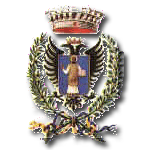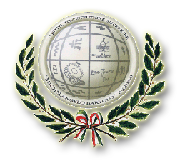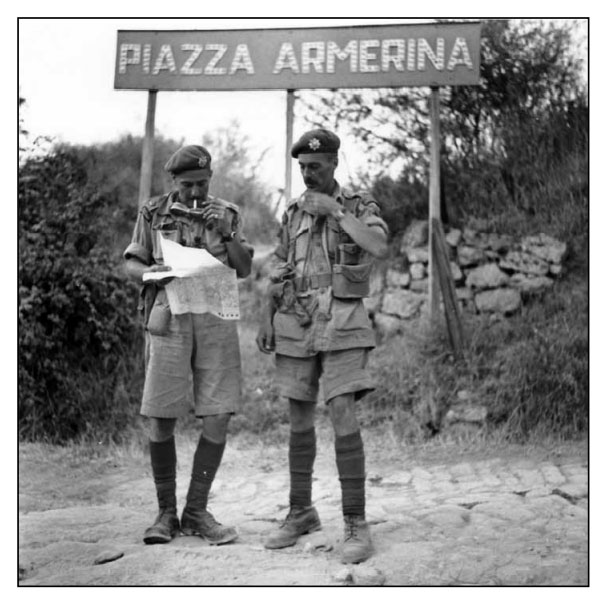
 Translate
Translate
-
* News
- - Agira 2018, 75 years later
- - Agira 2013, 70 years later
- - Gallery of ceremony 2013
- - Operation Husky 2013
- * Students' Contribute
- * About Us
- * Visitor's Book
- * Collaborators
- * Canadian Battles
- * Italian Defensive Positions
- * Allied Forces
- * Historical Movies
- Historical Information
- Historical Maps
- * Bibliography
- Biographies
- * Catania War Cemetery
- * Moro River War Cemetery
- * Syracuse War Cemetery




Piazza Armerina was a Battle Honour granted to Canadian regiments that fought at that town during the Battle of Sicily, a phase of the Italian Campaign during the Second World War.
 Early on 16 July, The Loyal Edmonton Regiment and a squadron of tanks from The Three Rivers Regiment led the 2nd Brigade Group up Highway 124 from Caltagirone, passing through San Michele di Ganzeria which was not occupied by the enemy, and turned north onto Highway 117, the Gela-Enna highway. The battle group found itself three miles south of Piazza Armerina by noon; this was yet another small rural town of 22,000 people, and at 2,366 feet above sea level was the highest in altitude of any town yet encountered by Canadian troops on Sicily.
Early on 16 July, The Loyal Edmonton Regiment and a squadron of tanks from The Three Rivers Regiment led the 2nd Brigade Group up Highway 124 from Caltagirone, passing through San Michele di Ganzeria which was not occupied by the enemy, and turned north onto Highway 117, the Gela-Enna highway. The battle group found itself three miles south of Piazza Armerina by noon; this was yet another small rural town of 22,000 people, and at 2,366 feet above sea level was the highest in altitude of any town yet encountered by Canadian troops on Sicily.
As the lead elements approached a sharp bend in the road, descending from a long level ridge to where it skirted a narrow and steep gully, they came under fire from machine guns, mortars and artillery. The road to Piazza Armerina was exposed all the way to the town, where the Germans had once again selected good positions with a commanding view. Two companies of the Edmontons worked forward to high ground on each side of the road, but mortars sited on two prominences a mile north and north-east continued to fire accurately on them.
The Edmontons, less “D” Company, still in Ragusa, were ordered to move against the hills, with “A” and “B” Companies making the initial attack and “C” in reserve. “A” Company managed to fight onto its objective through enemy fire, and “C” was sent to reinforce this success. The battle had been an infantry-only engagement, as the tanks were unable to elevate their guns to reach the German positions; only the battalion’s integral 3-inch mortar platoon had been available for fire support. Later in the day, the Royal Devon Yeomanry were able to provide indirect artillery fire, and the 5.5-inch guns of the 7th Medium Regiment also added weight to artillery support.
“B” Company, however, faced more trouble as it attempted to fight uphill during the course of the afternoon, and lost contact with battalion headquarters. Part of the company was pinned down in an orchard, but eventually a single platoon crested the hill and precipitated a German withdrawal.
The 2nd Battalion of the 104th Panzer Grenadier Regiment was not yet ready to leave the town of Piazza Armerina itself, and 7.5cm artillery fire continued to hit the Canadian positions until the British 5.5-inch medium guns silenced the German batteries. It wasn’t until after nightfall that the Germans pulled out of the town, which was declared secure by 0600 the next morning.
It was the first combat action for The Loyal Edmonton Regiment, and had cost them 27 casualties. The town itself had served as the location of an Italian corps headquarters, and signal equipment and gasoline were obtained in large quantities from enemy stocks.
Once again, the enemy had fought an effective delaying action, holding the 1st Canadian Division up for 24 hours; it was noon on the 17th before the 3rd Brigade was able to pass through the 2nd in Piazza Armerina and resume the advance on Enna, taking the lead in the Canadian vanguard for the first time on Sicily.
There was a real need for urgency for the 1st Division to make progress, on the left wing of the 8th Army, as the 13th Corps on the right wing was facing determined resistance at the Simeto River. General Alexander, commanding the 15th Army Group to which both Allied armies on Sicily belonged, issued a new directive on 16 July laying out three axes of advance for the 8th Army; firstly north from Catania, secondly from Leonforte to Adrano, in order to “sever communications this side of Etna” and finally via Nicosia-Troina-Randazzo to sweep around the northern slopes of Mount Etna.
The general plan was thus to move quickly before the Germans could crystallize an effective defence, with the Canadians moving behind Mount Etna from the west. Enna itself passed into the planned American area of operation, with the 7th Army tasked to protect the rear of the 8th Army.
None of these plans would be effective without the fall of Catania, and even by 17-18 July, British operations continued to falter. According to the Canadian official historian:
It will be observed that the directive based future operations for the Eighth Army upon the capture of Catania. Enemy resistance before the port, however, showed little sign of diminishing; a costly attack by the 50th Division on the night of 17-18 July to enlarge the Simeto bridgehead achieved little.This stalemate in the east heightened the importance of the Eighth Army's other axes of advance, and caused a modification of Montgomery's plans for the proposed northern sweep by the 30th Corps on the left flank. In a signal to Alexander on the 17th he reported that the 51st Highland Division was moving north from Scordia to "capture Paterno to-morrow with luck", and declared his intention of sending the Canadians--whom he expected to reach Enna that night-eastward from Leonforte to Adrano, rather than along the wider arc through Nicosia and Troina. "I will then operate with 30 Corps round the west and north of Etna and will cut off any enemy who stay east of Etna and about Catania." He further suggested that the Americans after capturing Petralia should drive to the coast road and "make faces eastwards" along the coast, thereby completing the bisection of the island and hemming the enemy within the Messina peninsula.For the Canadian Division this programme in the main was to remain unchanged.
The 3rd Brigade, setting off for Enna, could see that the distance from Piazza Armerina, even over winding hillside roads, was only 22 miles. However, the initial goal of reaching Enna on 17 July fell out of reach after only four miles, when a blown bridge was found and sappers of the 4th Field Company, Royal Canadian Engineers, were brought forward to build a diversion. When the 3rd Brigade was just eight miles from Piazza Armerina, they reached a junction branching off of Highway 117, towards Valguarnera. The Germans were in a position to delay advance in two directions by obstructing the junction, both northwest towards Enna, and northeast to Valguarnera, which looked out over the Dittaino valley and the western flats of the Catania plain.
Troops of the 2nd Battalion, 104th Panzer Grenadier Regiment, having just withdrawn from Piazza Armerina, now lay in ambush here just before the junction, at a spot that Highway 117 stretched through a narrow gap in a long ridge. The Canadian historian surmised that troops of their 1st Battalion, pulling back from the American front, joined them here. They set up outposts on the hill tops, including the Monte della Forma, 2,700 feet high on the west side of the pass, and sited mortars on the reverse slope.
In the action that followed the enemy demonstrated that two determined battalions by exploiting naturally strong positions could effectively hold up two brigades for more than twenty-four hours.
The first Carleton and York Regiment, travelling in the lead of the 3rd Brigade column, cane under fire shortly after 0430, having traversed the bypass and come into the ambush zone. Under mortar and machine gun fire, the Carleton and York infantry dismounted, while tanks of the Three Rivers Regiment fired on the Germans from one and a half miles south. The enemy was driven back to their main line of defence, and the Carleton and York proceeded to within a mile of Grottacalda pass.
The following Canadian units were awarded the Battle Honour "Piazza Armerina" for participation in these actions:
 1st Canadian Armoured Brigade
1st Canadian Armoured Brigade
-
12th Canadian Armoured Regiment (The Three Rivers Regiment)
 2nd Canadian Brigade
2nd Canadian Brigade
-
The Loyal Edmonton Regiment
References
-
Nicholson, Gerald Official History of the Canadian Army in the Second World War: Volume II: The Canadians in Italy



